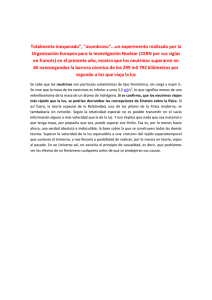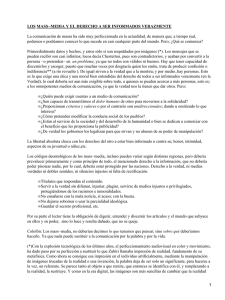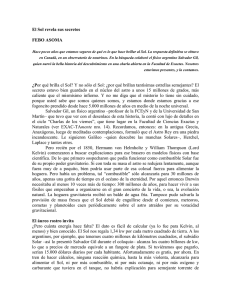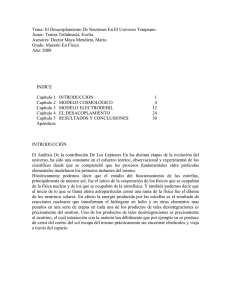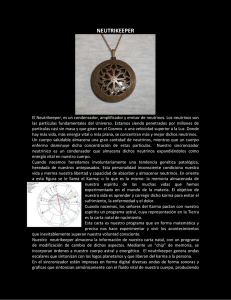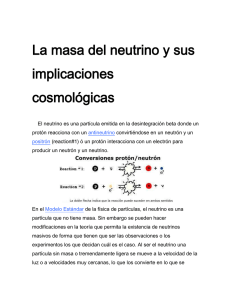Física de Neutrinos
Anuncio
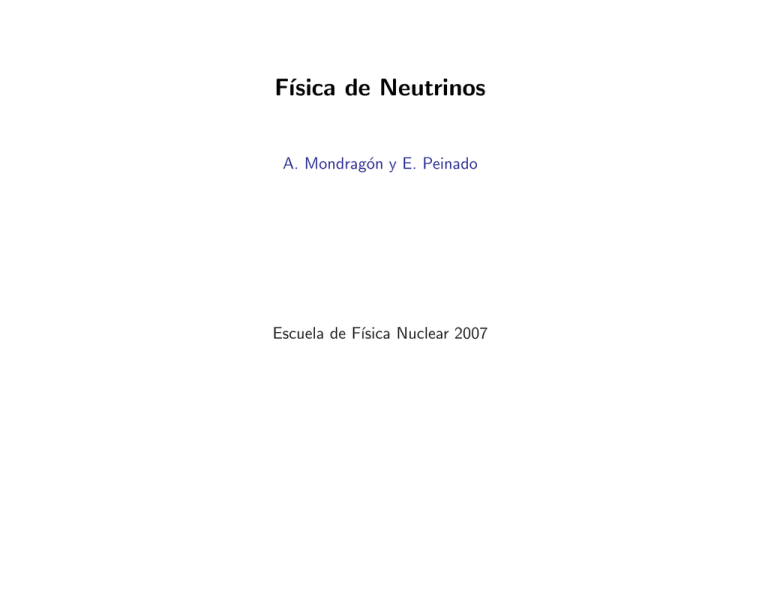
Fı́sica de Neutrinos A. Mondragón y E. Peinado Escuela de Fı́sica Nuclear 2007 Contenido Primera Parte • Oscilaciones de los neutrinos entre estados del sabor • Observaciones y Experimentos • Breve recordatorio de la Teorı́a: Modelo Estándar • Neutrinos de Dirac y Majorana • El mecanismo del subibaja (seesaw) Segunda Parte • Neutrinos en la Extensión S3-invariante del Modelo Estándar • Las corrientes neutras que cambian el sabor 1 NEUTRINOS Masas, mezclas de sabores y oscilaciones de los neutrinos 1957 Pontecorvo discutió las oscilaciones ν ↔ ν̄ 1962 Maki, Nakagawa y Sakata propusieron las ”Transiciones virtuales” νe ↔ νµ 1964-1968 Davies observó el déficit de νe solares 1998 Oscilaciones de los neutrinos νµ atmosféricos (SuperKamiokande) 2000 Observación directa de ντ en el experimento DONUT 2001 SNO mide las oscilaciones de los neutrinos νe solares y el flujo total de neutrinos provenientes del Sol 2003 KAMLAND mide los parámetros de la oscilación de los neutrinos νe solares y los de la oscilación de los ν̄e de reactores 2003-2007 Se midieron las diferencias de los cuadrados de las masas ∆m2ν ,ν y los ángulos i j de mezcla en las oscilaciones de los neutrinos entre estados del sabor y se refinaron las cotas sobre la suma de las masas de los neutrinos con las medidas cosmológicas de presición. ESTA ES LA EVIDENCIA EXPERIMENTAL INCONTROVERTIBLE DE FISICA NUEVA MAS ALLA DEL MODELO STANDARD !! 2 3 Oscilaciones del sabor |να i ≈ να W ∗ U i αi |νi i P α =sabor i =masa Propagación de los eigenestados de la masa + |νi(τ )i = e−imiτi |νi(0)i ≈ e−i(Eit−pi x)|νi(0)i lα+ |να(L)i ≈ m2 ∗ −i 2Ei L |νi i i Uαi e P Propagación de los estados del sabor |να (L) >≈ XhX β i i m2 ∗ − iL Uαi e 2E Uβi |νβ > La probabilidad de transición está dada por P (να → νβ ) = δαβ − 4 +2 h“ ” ˜i ˆ ∗ ∗ 2 L 2 Uαi Uβi Uαj Uβj sin 1.27∆mij ( E ) i>j Re P i h“ ” ∗ ∗ 2 L Uαi Uβi Uαj Uβj sin[2.54∆mij ( E ] i>j Im P 4 5 6 7 8 9 10 11 12 13 14 Grupo de Norma del Modelo Standard SUc(3) ⊗ SUW (2) ⊗ UY (1) ⇑ ⇑ fuerte débil ⇑ electromagnética Los campos fermiónicos se describen por sus componentes de quiralidad izquierda o derecha ψL,R = 1 (1 ± γ5)ψ, 2 ψ̄L,R = ψ̄(1 ± γ5) I 1 2 I QLi(3, 2)+1/6 , uRi (3, 1)+2/3 , dRi (3, 1)−1/3, LLi (1, 2), lRi (1, 1) sabor, color, isospin débil, hipercarga En el Modelo Standard hay un campo escalar llamado el campo de Higgs φ(1, 2)+1/2 15 Interacciones de Norma del Modelo Standard GM S = SUc (3) ⊗ SUW (2) ⊗ UY (1) ⇑ ⇑ fuerte (color) ⇑ débil electromagnética La lagrangiana del Modelo Standard L = Lkn + Lkf + LY + LH Invariancia de Norma: ψ̂(x) → ψ̂ ′(x) = U (x)ψ̂(x)U + (x) µ µ µ µ ′ U (x) ǫ GM S µ ∂ → D + igs Ga La + igAb Tb + ig B Y Gµa(x) son los 8 campos de los gluones Aµb(x) son los 3 bosones intermediarios de la interaccions débil B µ(x) es el bosón de la hipercarga 16 La Lagrangiana del Modelo Standard L = Lkn + Lkf + LY + LH Energı́a cinética de los campos de Norma: 1 1 1 µν µν µν Lkn = − Fµν F − Bµν B − Gµν G 4 4 4 a a a Fµν = ∂µAν − ∂ν Aµ + gǫ ijk j k Aµ Aν Bµν = ∂µBν − ∂ν Bµ a a a Gµν = ∂µGaµν − ∂ν Gµ + gs f ijk j k GµCν 17 La Lagrangiana de los fermiones Lkf X ¯+ µ ˆψ γ Dµψ̂ + = i i i µ µ µ µ ′ µ D = ∂ + igs Ga La + igAb Tb + ig B (x)Y Lagrangiana del campo de Higgs µ † + LH = (D φ) (Dµ φ) − V (φ φ) o 1 n α φ(x) = √ h(x)12×2 + iwα (x)σ 2 µ D φ(x) = “ ” i i ′ ~ µ − g Bµ φ τ ·A ∂µ − g~ 2 2 2 + + 2 V (φ) = −µ φ φ + λ(φ φ) 18 Lagrangiana de Yukawa 3 “ X −LY = i,j=1 (ℓ) 1 − σ3 ν̄ℓi , ℓ̄i Γij φ L 2 3 “ X i,j=1 3 “ X i,j=1 „ « νℓj + ℓj R ” (u) 1 + σ3 ūi , d¯i Γij L 2 ” (d) 1 − σ3 ūi d¯i Γij L 2 ” „ uj dj „ « uj + dj R « + c.h. R Γij son matrices complejas y hermitianas. Conjugación de carga (C) y paridad (P) CP : bajo CP: ∗ + ψ̄LiφψRj ←→ ψ̄Rj φ ψLi + ∗ + Γij ψ̄Li φψRj + Γij ψ̄Rj φ ψLi ←→ (Γij ψ̄Li φψRj + Γij ψ̄Rj φ ψLi ) LY invariante bajo CP si y sólo si Γij = Γ∗ij Violación de CP en el Modelo Standard !! n o (f ) ∗(f ) d d† † Γij 6= Γij y Im det[Γ Γ , ΓuΓu] 6= 0 19 Masas de los fermiones Mecanismo de Higgs: Cuando se rompe espontáneamente la simetrı́a de norma < 0|φ(x)|0 >= v 6= 0 las interacciones de Yukawa generan las masas de los fermiones I l I LM ass = d¯ILiMdij dIRj + ūILi Muij uIRj + l̄Li Mij lRj + h.c. Matrices de masas: 1 (f ) (f ) Mij = √ v Γij 2 Violación de CP CP se viola si y sólo si (f ) (f )∗ Mij 6= Mij Si las matrices de masas son hermitianas n h io d u Im det M , M 6= 0 ⇔ CP 20 Los Neutrinos en el Modelo Estándar En el Modelo Estándar • Las masas de los quarks y los leptones cargados se generan en los sectores de Higgs y de Yukawa • Los neutrinos no tienen masa • El sector de Yukawa tiene demasiados parámetros libres (13) Por lo tanto, debemos extender la teorı́a, con el objetivo de • Dar masa a los neutrinos • Sistematizar la fenomenologı́a tan rica de las masas y mezclas de los fermiones • Reducir el número de parámetros En las Extensiones del Modelo Standard • Extendimos el concepto del sabor y generación al sector de Higgs • Introdujimos una simetrı́a permutacional del sabor en el sector de las masas • Generamos las masas de los neutrinos con el mecanismo del subibaja 21 Neutrinos de Dirac y Neutrinos de Majorana I Espinores de Dirac µ iγ ∂µψ − mψ = 0. Lagrangiana de Dirac λ LD = iψ̄γ ∂λψ − mψ̄ψ Relación de energı́a y momento λ 2 p pλ = m ψ es un espinor de cuatro componentes γ µ son las matrices de Dirac Neutrinos de Dirac 6= Antineutrinos de Dirac 22 Neutrinos de Dirac y Neutrinos de Majorana II Espinores de Majorana La carga eléctrica de los neutrinos es nula Si el campo espinorial = al campo conjugado de carga c ψM = ψM = C ψ̄ T C es la matriz de conjugación de carga ψM = „ ν iσ2ν ∗ « ψM es un espinor de Majorana y tiene sólo dos componentes Neutrinos de Majorana = Antineutrinos de Majorana 23 Las extensiones del Modelo Standard permiten Mν 6= 0 I Extender el sector de leptones agregando la parte derecha de los neutrinos II Extender tanto el sector leptónico como el sector de Higgs Neutrinos estériles: Se agregan m campos fermiónicos neutros en singletes de SU (2)W y de quiralidad derecha. Q = T3 + Y = 0 ⇒ −LN = νsI i “ ” 1, 1 0 8 < Singletes de SU (3)C Singletes de SU (2)L : hipercarga cero 1 c ν N̄i MNij Nj + Γij L̄Li φ̃Nj + h.c. 2 Después del rompimiento espontáneo de la simetrı́a de norma ` −LMν = ν̄Li MD ´ ν ij sj ´ 1 c` + ν̄s MR ij νsj + h.c. 2 i 24 El Mecanismo del Subibaja (seesaw) El mecanismo del subibaja ~ ν= νL I νsj ! i = 1, 2, 3; j = 4, 5, ....m −LMν = ` ~ νL ´ ν̄sc MN = si MR ∼ <φ> ΛF N „ „ 0 T MD 0 T MD MD MR MD MR «„ c νL νs « « << 1 Ecuaciones de movimiento: δLMν −1 −1 T T T y νR = −MR MD ν̄L ) δνR = 0 → (νR = −ν̄L MD MR se obtiene LMν = − 12 ν̄LMcν νLc + h.c. Mν = −MD MR−1MD . 25 26 Contents • Flavour permutational symmetry • A minimal S3 -invariant extension of the Standard Model • Masses and mixings in the leptonic sector • The neutrino mass spectrum • FCNCs • Summary and conclusions 27 Flavour permutational symmetry • Prior to the introduction of the Higgs boson and mass terms, the Langrangian of the Standard Model is chiral and invariant with respect to any permutation of the left and right quark fields. GF ∼ S3L ⊗ S3R • Charged currents Jµ are invariant under GF if the d and u−type fields are transformed with the same family group matrix Jµ = −iūLγµdL + h.c. ⇒ GF ∼ S3 ⊂ S3L ⊗ S3R • When < 0|ΦH |0 >6= 0, the Yukawa couplings give mass to quarks and leptons, if we assume that the S3 permutational symmetry is not broken 0 1 1 1 1 1 Mq = m3q @1 1 1A 3 1 1 1 mt 6= 0, me = mµ = 0; mb 6= 0, ms = md = 0 mτ 6= 0, mµ = me = 0; mντ = mνµ = mνe = 0 V=1 There is no mixing nor CP- violation. 28 The Group S3 The group S3 of permutations of three objects Permutations Rotations 3 „ 1 3 V1 2 1 3 2 « ⇐⇒ a 120◦− rotation around the invariant vector V1 V2A 2 „ 1 2 2 1 3 3 « ⇐⇒ a 180◦rotation around the invariant vector V2s V2s 1 Symmetry adapted basis |v2A 0 1 0 1 1 1 1 1 1 1 1 >= √ @−1A , |v2s >= √ @ 1 A , |v1 >= √ @1A 3 1 2 6 −2 0 0 29 Irreducible representations of S3 The group S3 has two one-dimensional irreps (singlets ) and one two-dimensional irrep (doublet) • one dimensional: 1A antisymmetric singlet, 1s symmetric singlet • Two - dimensional: 2 doublet Direct product of irreps of S3 1s ⊗ 1s = 1s , 1s ⊗ 1A = 1A , 1A ⊗ 1A = 1s , 1s ⊗ 2 = 2, 1A ⊗ 2 = 2 2 ⊗ 2 = 1s ⊕ 1A ⊕ 2 the direct (tensor) product of two doublets « „ pD1 pD = and pD2 qD « „ qD1 = qD2 T has two singlets, rs and rA, and one doublet rD rs = pD1qD1 + pD2qD2 is invariant, T rD = „ rA = pD1 qD2 − pD2 qD1 pD1 qD2 + pD2qD1 pD1qD1 − pD2qD2 is not invariant « 30 A Minimal, S3 invariant extension of the SM The Higgs sector is modified, Φ→H = T (Φ1, Φ2, Φ3 ) H is a reducible 1s ⊕ 2 rep. of S3 Hs HD = = ” 1 “ √ Φ1 + Φ2 + Φ3 3 0 B @ √1 (Φ1 2 − Φ2 ) 1 C A 1 √ (Φ1 + Φ2 − 2Φ3 ) 6 Quark, lepton and Higgs fields are QT = (uL , dL), uR , dR , L† = (νL, eL), eR , νR, H All these fields have three species (flavours) and belong to a reducible 1⊕ 2 rep. of S3 31 The most general renormalizable Yukawa interactions LY = LYD + LYu + LYE + LYν Quarks LYD = −Y1dQI HS dIR − Y3dQ3 HS d3R − Y2d[ QI κIJ H1dJR + QI ηIJ H2dJR ] − Y4 Q3HI dIR − Y5 QI HI d3R + h.c d LYU d = −Y1uQI (iσ2)HS∗ uIR − Y3uQ3 (iσ2)HS∗ u3R − Y2u[ QI κIJ (iσ2)H1∗ uJR + ηQI ηIJ (iσ2 )H2∗uJR ] − Y4 Q3 (iσ2)HI uIR − Y5 QI (iσ2)HI u3R + h.c., u ∗ ∗ u Doublets carry indices I, J = 1, 2 „ 0 κ= 1 « 1 0 y η= „ 1 0 « 0 1 Singlets carry the index s or 3 32 Yukawa interaction II Leptons LYE = −Y1e LI HS eIR − Y3e L3HS e3R − Y2e [ LI κIJ H1 eJR + LI ηIJ H2 eJR ] − Y4 L3HI eIR − Y5 LI HI e3R + h.c., e LYν e = −Y1ν LI (iσ2)HS∗ νIR − Y3ν L3(iσ2 )HS∗ ν3R − Y2 [ LI κIJ (iσ2 )H1 νJR + LI ηIJ (iσ2 )H2 νJR ] − ν ∗ ∗ Y4ν L3(iσ2 )HI∗νIR − Y5ν LI (iσ2 )HI∗ν3R + h.c. I, J = 1, 2 Furthermore, the Majorana mass terms for the right handed neutrinos are LM = T T −M1νIR CνIR − M3 ν3R Cν3R , C is the charge conjugation matrix. 33 The Higgs potential V V1 = + V2 = V1 + V2 h i µ (H̄D1 HD1) + (H̄D2 HD2) + (H̄3 H3 ) 2 i2 1 h λ1 (H̄D1 HD1) + (H̄D2 HD2) + (H̄3 H3) 2 = h i η1 (H̄3H3 ) (H̄D1 HD1 + H̄D2HD2) where 1 HD2 = √ (Φ1 + Φ2 − 2Φ3) 6 1 HD1 = √ (Φ1 − Φ2), 2 H3 = 1 √ (Φ1 + Φ2 + Φ3) 3 34 Mass matrices We will assume that < HD1 > = < HD2 > 6= 0 < H3 > 6= 0 and and 2 2 < H3 > + < HD1 > + < HD2 > 2 ≈ “ 246 2 GeV ”2 Then, the Yukawa interactions yield mass matrices of the general form 0 µ1 + µ2 M = @ µ2 µ4 µ2 µ1 − µ2 µ4 1 µ5 µ5 A µ3 The Majorana masses for νL are obtained from the see-saw mechanism Mν = MνD M̃ −1 T (MνD ) with M̃ = diag(M1 , M1 , M3) 35 Mixing matrices The mass matrices are diagonalized by unitary matrices † Ud(u,e)L Md(u,e)Ud(u,e)R “ = diag md(u,e)ms(c,µ)mb(t,τ ) and Uν† Mν Uν = “ diag mν1 , mν2 , mν3 The masses can be complex, and so, UeL is such that † MeMe† UeL UeL = “ 2 2 diag |me | , |mµ | , |mτ | The quark mixing matrix is VCKM = ” ” 2 ” , etc. † UdL UuL and, the neutrino mixing matrix is VM N S = † UeLUν 36 The leptonic sector To achieve a further reduction of the number of parameters, in the leptonic sector, we introduce an additional discrete Z2 symmetry − HI , ν3R + HS , L3 , LI , e3R , eIR , νIR then, e e ν ν Y1 = Y3 = Y1 = Y5 = 0 Hence, the leptonic mass matrices are 0 e µ2 Me = @µe2 µe4 µe2 −µe2 µe4 1 µe5 µe5 A 0 and MνD µν2 = @µν2 µν4 0 µν2 −µν2 µν4 1 0 0A µν3 37 Mass matrix of the charged leptons The unitary matrix UeL is calculated from † 2 2 † = diag(me , mµ, mτ ) 2|µe2 |2 |µe5 |2 |µe5|2 2µ2 µ∗4 |µe5 |2 2|µe2 |2 + |µe5 |2 0 2µ∗2 µ4 0 2|µe4 |2 UeL MeMeLUeL 2 where † Me Me = 0 B B B B B @ + 1 C C C C C A • We reparametrize Me Me† in terms of its eigenvalues • Then, we compute UeL as function of the mass eigenvalues of MeMe† 38 Reparametrization of the mass matrix I From the invariants of Me Me† we obtain † 2 2 2 T r(Me Me ) = me + mµ + mτ = m2τ h “ ”i 2 2 2 4|µ̃2| + 2 |µ̃4 | + |µ̃5 | , † 2 2 2 2 2 χ(Me Me ) = mτ (me + mµ) + me mµ = 4 4mτ and h “ ” i 4 2 2 2 2 2 |µ̃2 | + |µ̃2| |µ̃4| + |µ̃5 | + |µ̃4| |µ̃5| , † 2 2 2 6 2 2 det(Me Me ) = me mµmτ = 4mτ |µ̃2 | |µ̃4 | |µ̃5 | 2 39 Reparametrization of the Mass Matrix II Solving for the parameters |µ̃2 |2, |µ̃4 |2, and |µ̃5|2 , in terms of mµ/mτ and me /mτ we get, |µ̃2| 2 |µ̃4,5| = 1 4 “ 1− 2 2 2 (1−x ) m̃µ 1+x2 − 4β 2 = m̃2 µ 1+x4 2 1+x2 (1) +β ” v 0 u u“ ” u 2 )2 2 2 2 B (1−x 1+x2 1u 2 (1−x ) + ∓ 4 t 1 − m̃2µ 1+x2 − 8m̃2e 1+x + 8β 1 − m̃ @ 4 µ 1+x2 1 (1+x2 )2 C x2 A 2β(1+x2 ) (1+x4 )2 1+ 2 m̃µ (1+x4 ) + 16β 2 (2) and x = me/mµ , 2 2 1 me mµ β≈ 2 m4τ 40 β is the smallest root of the cubic equation: z 2 1 z z2 1 2 β − (1 − 2y + 6 )β − (y − y − 4 + 7z − 12 2 )β − 2 y 4 y y 3 1 z2 z3 3 z2 1 yz − − 3 =0 + 2 8 2y 4y y 41 The Mass Matrix of the charged leptons as function of its eigenvalues The mass matrix of the charged leptons is 0 m̃µ √1 √ B 2 1+x2 B B B B B m̃ √1 √ µ Me ≈ mτ B B 2 1+x2 B B B @ qm̃e (1+x2 ) iδe e 1+x2 −m̃2 µ m̃µ √1 √ 2 1+x2 m̃ − √1 √ µ 2 1+x2 m̃ (1+x2 ) iδe q e e 1+x2 −m̃2 µ √1 2 r 1+x2 −m̃2 µ C 1+x2 1 C C C r C 2 1+x2 −m̃µ C 1 √ C. C 2 1+x2 C C C A 0 (3) This expression is accurate to order 10−9 in units of the τ mass There are no free parameters in Me other than the Dirac Phase δ!! 42 The Unitary Matrix UeL The unitary matrix UeL is calculated from We find ` 2 2 † 2´ † UeL Me MeLUeL = diag me , mµ, mτ UeL = ΦeLOeL , and 0 OeL ˆ ˜ ΦeL = diag 1, 1, eiδD 2 2 4 (1+2m̃2 µ +4x +m̃µ +2m̃e ) √1 x q 4 6 2 2 2 4 1+m̃2 µ +5x −m̃µ −m̃µ +m̃e +12x B B B B 2 B (1+4x2 −m̃4 µ −2m̃e ) B − √1 x q ≈B 4 6 2 2 2 4 1+m̃2 B µ +5x −m̃µ −m̃µ +m̃e +12x B B q B 2 2 2 2 1+2x2 −m̃2 @ µ −m̃e (1+m̃µ +x −2m̃e ) −q 2 4 6 2 2 4 1+m̃µ +5x −m̃µ −m̃µ +m̃e +12x − √12 q 2 4 (1−2m̃2 µ +m̃µ −2m̃e ) √1 2 4 6 2 2 1−4m̃2 µ +x +6m̃µ −4m̃µ −5m̃e 4 (1−2m̃2 µ +m̃µ ) 1 √ q 2 1−4m̃2 +x2 +6m̃4 −4m̃6 −5m̃2 µ µ µ e q 2 ) 1+2x2 −m̃2 −m̃2 −2 m̃ (1+x2 −m̃2 µ e e µ −x q 4 6 2 2 1−4m̃2 µ +x +6m̃µ −4m̃µ −5m̃e 1 √1 2 √ 1+x2 m̃e m̃µ q 1+x2 −m̃2 µ (4) 43 C C C C C C C , C C C C A The neutrino mass matrix I The neutrino mass matrix is obtained from the see-saw mechanism Mν = 0 2(ρν2 )2 −1 T MνD M̃ (MνD ) = @ 0 2ρν2 ρν4 0 2(ρν2 )2 0 1 2ρν2 ρν4 A 0 2(ρν4 )2 + (ρν3 )2 Mν is reparametrized in terms of its eigenvalues 0 mν3 B Mν = B 0 @ q (mν3 − mν1 )(mν2 − mν3 )e−iδν 0 mν3 0 q 1 −iδν (mν3 − mν1 )(mν2 − mν3 )e C C. 0 A −2iδν (mν1 + mν2 − mν3 )e (5) 44 Neutrino Mass Matrix II The complex symmetric matrix Mν is diagonalized as T Uν M ν Uν = 0 |mν1 |eiφ1−iφν @ 0 0 where 0 1 Uν = @ 0 0 0 1 0 0 0 eiδν 0 1B B B AB B B @ s − 0 |mν2 |eiφ2−iφν 0 mν2 − mν3 mν2 − mν1 s 0 mν3 − mν1 mν2 − mν1 s 1 0 0 A |mν3 | mν3 − mν1 mν2 − mν1 0 s mν2 − mν3 mν2 − mν1 1 0 C C C 1 C C. C A 0 (6) the mass eigenvalues, mν1 , mν2 and mν3 are, in general, complex numbers 45 All the phases in Mν except for one, can be absorbed in a rephasing of the fields the phases φ1 and φ2 are fixed by the condition |mν3 | sin φν = |mν2 | sin φ2 = |mν1 | sin φ1 and therefore mν2 − mν3 mν3 − mν1 = (∆m212 + ∆m213 + |mν3 |2 cos2 φν )1/2 − |mν3 || cos φν | (∆m213 + |mν3 |2 cos2 φν )1/2 + |mν3 || cos φν | . (7) 46 The neutrino mixing matrix I † VPthM N S = UeL Uν The theoretical mixing matrix VPthM N S is VPthM N S = × 0 O11 cos η + O31 sin ηeiδ B B B B −O12 cos η + O32 sin ηeiδ B @ O13 cos η − O33 sin ηeiδ 1 @ 0 0 0 0 eα 0 O11 sin η − O31 cos ηeiδ −O21 −O12 sin η − O32 cos ηeiδ O22 O13 sin η + O33 cos ηeiδ O23 1 C C C C C A (8) 1 0 0 A eiβ where Oij are the absolute values of the elements of Oe P DG VP M N S = 0 c12 c13 B @ −s12 c23 − c12 s23 s13 eiδ s12 s23 − c12 c23 s13 eiδ s12 c13 c12 c23 − s12 s23 s13 eiδ −c12 s23 − s12 c23 s13 eiδ −iδ s13 e s23 c13 c23 c13 10 1 CB A@ 0 0 0 eiα 0 1 0 C 0 A eiβ 47 The parameters in VP M N S I From our previous expressions, the parameters in VP M N S are sin θ13 ≈ sin θ23 ≈ 2 tan θ12 = (1+4x2 −m̃4 µ) √1 x q , 2 2 −m̃4 1+m̃2 +5x µ µ (9) 4 1−2m̃2 µ +m̃µ 1 √ q . 2 1−4m̃2 +x2 +6m̃4 µ µ (∆m212 + ∆m213 + |mν3 |2 cos2 φν )1/2 − |mν3 || cos φν | (∆m213 + |mν3 |2 cos2 φν )1/2 + |mν3 || cos φν | . 48 The parameters in VM N S II The Majorana phases are sin 2α = sin(φ1 − φ2 ) = |mν3 | sin φν |mν1 ||mν2 | × « „q q |mν2 |2 − |mν3 |2 sin2 φν + |mν1 |2 − |mν3 |2 sin2 φν sin 2β = sin(φ1 − φν ) = « „ q q sin φν |mν3 | 1 − sin2 φν + |mν1 |2 − |mν3 |2 sin2 φν . |mν1 | The mixing angles θ13 and θ23 depend only on the charged lepton masses and are in excellent agreement with the experimental values 2 Experimental Theoretical exp sin θ13 = 1.1 × 10 (sin θ13) 2 ≤ 0.025 +0.06 sin θ23 = 0.5−0.05 2 −5 2 sin θ23 = 0.499 49 The neutrino mass spectrum I In the present model, the experimental restriction |∆m221 | < |∆m223 | implies an inverted neutrino mass spectrum mν3 < mν1 , mν2 From our previous expressions q ∆m213 1 − tan4 θ12 + r 2 , |mν3 | = p p 2 cos φν tan θ12 1 + tan2 θ12 1 + tan2 θ12 + r 2 where r = ∆m221 /∆m223 . The mass |mν3 | assumes its minimal value when sin φν = 0, |mν3 | ≈ q 2 1 ∆m13 2 tan θ12 (1 − tan2 θ12) 50 Neutrino mass spectrum II • We wrote the neutrino mass differences, mνi − mνj , in terms of the differences of the squared masses ∆2ij = m2ν − m2ν and one of the neutrino masses, say mν3 . i j • The mass mν2 was taken as a free parameter in the fitting of our formula for tan θ12 to the experimental value • with 2 −3 ∆m13 = 2.6 × 10 eV 2 2 −5 ∆m21 = 7.9 × 10 eV 2 and tan θ12 = 0.667 we get |mν3 | ≈ 0.022eV =⇒ |mν2 | ≈ 0.056eV and |mν1 | ≈ 0.055eV 51 FCNC I In the Standard Model the FCNC a tree level are suppressed by the GIM mechanism. Models with more than one Higgs SU (2) doublet have tree level FCNC due to the interchange of scalar fields. The mass matrix written in temrs of the Yukawa couplings is e E1 0 E2 0 MY = Yw H1 + Yw H2 , FCNC processes: φ0 (k) φ0 (k) µ(p′ ) τ (p) µ(p′ ) τ (p) li µ li γ γ µ φ0 (k) µ φ0 τ µ(p′ ) τ (p) li γ Figure 1: The figure in the left contributes to the process τ − → 3µ. The tree figures in the right contribute to the process τ → µγ . 52 FCNC II The Yukawa matrices in the weak basis are 0 E1 Yw and B B B B mτ B B = v1 B B B B @ 0 YwE2 B B B B mτ B B = v2 B B B B @ r 1+x2 −m̃2 µ 2 1+x 0 m̃µ √1 √ 2 1+x2 m̃ √1 √ µ 2 1+x2 0 0 0 0 m̃ (1+x2 ) iδe q e e 1+x2 −m̃2 µ m̃µ √1 √ 2 1+x2 0 0 √1 2 0 m̃ − √12 √ µ 2 1+x m̃ (1+x2 ) iδe q e e 1+x2 −m̃2 µ 0 √1 2 r 1+x2 −m̃2 µ 2 1+x 0 1 C C C C C C C C C C A (10) 1 C C C C C C. C C C C A (11) 53 FCNC III The Yukawa matrices in the mass basis defined by † ỸmEI = UeL YwEI UeR E1 Ỹm and ỸmE2 0 − 12 m̃e 1 2x 1 2 m̃µ − 12 − 21 m̃µ 1 2 −m̃e 1 2 m̃e − 21 x m̃µ 1 2 m̃µ 1 2 − 21 m̃µ x2 1 2 m̃µ 1 2 2m̃e B mτ B B ≈ B −m̃µ v1 B @ 2 1 m̃ x µ 2 0 B mτ B B ≈ B v2 B @ 1 C C C C , C A m 1 C C C C , C A m 54 Branching ratios We define the partial branching ratio (only leptonic decays) Γ(τ → µe+ e−) Br(τ → µe e ) = Γ(τ → eν ν̄) + Γ(τ → µν ν̄) + − thus Br(τ → µe+e−) ≈ Similar computations lead to 9 4 „ me mµ m2τ 3α Br(τ → eγ) ≈ 8π „ «2 mµ MH mτ MH1,2 «4 !4 , , « „ « mµ 2 mτ 4 , mτ MH „ « 9 mµ 4 Br(τ → 3µ) ≈ , 64 MH « „ « „ me mµ 2 mτ 4 , Br(µ → 3e) ≈ 18 2 m MH „ τ «4 „ « mτ 4 27α me . Br(µ → eγ) ≈ 64π mµ MH 3α Br(τ → µγ) ≈ 128π „ 55 Numerical results Table 1: Leptonic processes via FCNC FCNC processes Theoretical BR τ → 3µ τ → µe+ e− τ → µγ τ → eγ µ → 3e µ → eγ 8.43 × 10−14 3.15 × 10−17 9.24 × 10−15 5.22 × 10−16 2.53 × 10−16 1 × 10−19 Experimental upper bound BR 2 × 10−7 2.7 × 10−7 6.8 × 10−8 1.1 × 10−11 1 × 10−12 1.2 × 10−11 References B. Aubert et. al. B. Aubert et. al. B. Aubert et. al. B. Aubert et. al. U. Bellgardt et al. M. L. Brooks et al. procesos FCNC pequeños que sirven de intermediarios a las interacciones no-standard de los leptones cargados y los neutrinos podrı́an tener importancia en la descripción teórica del colapso gravitacional del núcleo y la generación de choque en la etapa explosiva de una supernova 56 Muon Anomalous Magnetic Moment Models with more than one Higgs SU (2) doublet also contribute to the anomalous magnetic moment of the muon due to the interchange of scalars µ(p) Yµτ µ(p′) H(k) τ τ Yτµ γ(q) The Anomalous Magnetic Moment is ! 2 MH Yµτ Yτ µ mµ mτ log − δaµ = 2 16π 2 MH m2τ that is given by ! 3 2 −12 δaµ = 2.6 × 10 which is well below the difference SM ∆aµ = aexp = (287 ± 91) × 10−11 µ − aµ 57 Conclusions I • By introducing three SU (2)L Higgs doublet fields in the theory, we extended the concept of flavour and generations to the Higss sector and formulated a minimal S3 −invariant Extension of the Standard Model • A definite structure of the Yukawa couplings is obtained which permits the calculation of mass and mixing matrices for quarks and leptons in a unified way • A further reduction of free parameters is achieved in the leptonic sector by introducing a Z2 symmetry. • The three charged lepton masses, three Majorana masses of the left-handed neutrinos and the three mixing angles and the 2 Majorana phases are computed in terms of only seven free parameters, in agreement with all the experimental observations at this time • The magnitudes of the three mixing angles, θ12 , θ23 , and θ13, are determined by an interplay of the S3 × Z2 symmetry, the see saw mechanism and the lepton mass hierachy 58 Conclusions II • The mixing angles θ23 and θ13 are insensitive to the values of the neutrino masses • The solar mixing angle fixes the scale and origen of the mass spectrum • The neutrino mass spectrum has an inverted mass hierarchy with the values |mν2 | ≈ 0.056eV, |mν1 | ≈ 0.055eV |mν3 | ≈ 0.022eV, • Numerical values for FCNC below experimental constraints • FCNC processes considered are strongly suppressed by powers of the small mass ratios me /mτ and mµ/mτ , and by the ratio “ ”4 mτ /MH1,2 • Could be important in astrophysical processes 59

